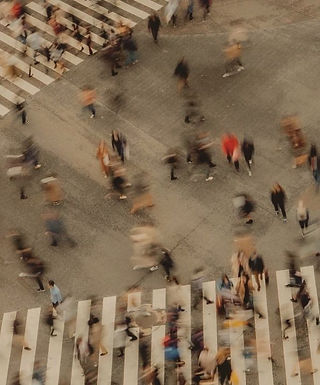University Graduate Project
Furniture Design · Wayfinding · Experience Strategy · Branding
A museum experience that slows the body so the mind can follow.



how IN FOCUS took shape
WHY IN FOCUS
A response to a world that looks but rarely sees.
the world we live in
We live in an age of overstimulation.
Surrounded by screens, notifications, and noise, our attention is fragmented, even in the spaces meant to restore it.
Cultural experiences have become fast-paced, performative, and emotionally thin.
The result: people leave having looked but never truly seen

the problem behind the pace
Grounded in secondary research,
understanding the cultural, emotional, and psychological context behind the project.

1in4
people worldwide struggle with mental health

70%
of art therapy participants report art as best tool for healing
.jpeg)
Museums
designed to inspire, lost to short attention spans
How might design reimagine museum seating as part of a wider system that helps visitors slow down, reflect, and reconnect with art?
PRIMARY RESEARCH
Grounded in real observation, emotion, and behaviour.

· Ethnographic Observation ·
· Seating Typology Analysis ·
· Behavioural Insight ·
See all research from the V&A Museum here
VICTORIA & ALBERT MUSEUM

· Auto ethnography ·
· Journey Mapping ·
· Sensory Environment Study ·
See all research from the GEM here
GRAND EGYPTIAN MUSEUM

· Qualitative Research ·
· Insight Synthesis ·
· Emotional Design Understanding ·

See all research from Interviews here
INTERVIEWS

“For the understanding of a picture a chair is needed. Why a chair? To prevent the legs, as they tire, from interfering with the mind.”
- PAUL KLEE
WHAT THE GALLERIES REVEALED
A response to a world that looks but rarely sees.
no space to pause when overwhelmed.
seating is disconnected, uncomfortable and poorly placed.
seats encourage escape, not connection.
no personal seating, only exposed communal spaces.


my design principles

why the Victoria & Albert Museum
The V&A is used as the testing ground for this project - a world-leading museum that faces the same challenges as cultural institutions everywhere: overstimulation, fatigue, and generic seating. By grounding IN FOCUS here, I could prototype within a rich context while creating a framework that scales to other galleries and cultural spaces.



DESIGNING AROUND POSTURES
Postures are the foundation of my designs, they shape how someone feels, how long they stay and how they interact with the space around them.
.png)
prototyping through bodystorming
Testing how posture, angle, and body support can foster reflection, rest, and connection.





From posture experiments to full-scale form testing






Because no single seat can hold every need - only a system can.
THE FOUR PAUSES

Solitary Reflection

Deep Contemplation

Quiet Togetherness

Momentarily Reset




A SYSTEM YOU CAN FOLLOW AT A GLANCE




Campaign, signage, and seat plaques work together to help visitors recognise each pause and navigate the experience intuitively.


The brochure guides visitors through the trail, introducing the four seats and helping them navigate IN FOCUS at their own pace.





BEHIND THE EXPERIENCE
IN FOCUS is more than furniture - it's a scalable, operational system for wellbeing in cultural spaces.





